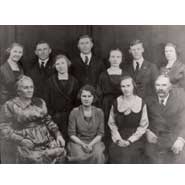There is a scene at the beginning of the movie Gone With the Wind when Scarlett O’Hara, who is eyeing Ashley Wilkes as a prospective beau, finds out that he is going to marry his (we don’t know how distant) cousin, Melanie. Thus begins a kinship web that family historians can relate to. It is also one of the reasons that researchers need to include siblings of ancestors in their search. As uncommon as it may seem, confusing relationships can happen fairly often and have in almost every family.
I call it “being related twice” – once by blood and once by marriage, and it has happened in my family. I have mentioned in earlier blogs that my dad came from a close knit German community in Des Moines County, Iowa. Before railroads, travel wasn’t easy, so families usually stayed fairly close to home. For a number of reasons families often had eight children or more. Lots of neighbors, lots of children and lots of marriages.
My Family:
Herman RIEPE and Anna ENGELBRECHT. They were married in Germany and came to the United States in about 1850. Their children:
- Anna Maria, b. 23 July 1853; m. 20 Dec. 1870, 1. John F. Roedel, d. 28 Nov. 1880; m. 7 Mar. 1885, 2. William Ernest Breuer
- Hannah Louisa, b. 15 May 1855; d. 15 Nov. 1883; m. 17 Dec. 1874, William Ernest Breuer
- Albert, b. 1857
- Henry Herman, b. 5 September 1858
- John Frederick, b. 10 August 1862; m. 16 Feb. 1887, Anna Rosetta Heitmeier
- Herman August, b. September 1863
- Martha K., b. 3 November 1864
- Edward Gotlieb, b. 14 August 1866; m. 24 Sept. 1895, Catherine I. Heitmeier
- August William, b. 1 August 1869
- Julius, b. 1874; d. April 1906 in the San Francisco earthquake
- John Frederick William, b. 26 June 1875
Marriages can drive family historians a little bit crazy because simple family relationships get complicated in a hurry. When siblings of one family marry the siblings of another family, it can get confusing. If a marriage with children involves the death of a spouse, and there is a subsequent re-marriage, then blended families come into play – blended families are not a 20th Century invention – and diagrams may be needed.
Take my family or example (see above). First, there are the Riepe brothers and the Heitmeier sisters. J. Frederick (John Frederick) Riepe married Anna Heitmeier on 16 Feb. 1887 and Edward Gotlieb Riepe married Catherine Heitmeier on 24 Sept. 1895:
- J. Fred Riepe m. Anna Heitmeier – 10 children
- Edward Riepe m. Catherine Heitmeier – 3 children
So, the brothers (blood) became brothers-in-law (marriage) and the sisters (blood) became sisters-in-law (marriage). Their 13 children were double cousins – both families shared the same grandparents.
The second scenario is not so simple. It involves two sisters, two spouse,s and three marriages. The oldest daughter of Herman Riepe, Anna Maria Riepe married John F. Roedel in 1870. Her sister, Hannah Louisa married William Ernest Breuer in 1874. John died in 1880 and Hannah died in 1883. Both families are found in the 1880 Census:
State of Indiana; Posey County; Lynn Township; P. 10; ED99
- Riddle (Roedel), John, 31
- Annie M., 21
- Josie, son, 2
- George, son, 1
State of Iowa; Union County; City of Creston; P. 93; ED 222:
- Breuer, William, 29
- Hannah, 25
- William, 4
- Nora, 3,
- Clara, 7/12
Anna and William – sister-in-law and brother-in-law – married in 1885. Both Anna and John and Hannah and William had children who were cousins, so when Anna and William married, the cousins also became step-siblings. Then came their children. From the 1900 U.S. Census for Clay Township, Lafayette County, Missouri:
- Breuer William, 49, head, b. Aug. 1850, m. 14 yrs
- Anna M., 46, wife, b. Jul. 1853, m. 14 yrs, 8 children, 7 living
- Clara, 21, dau., b. Nov. 1878
- Albert, 19, son, b. Jan. 1881
- (Hannah died in 1883.)
- Elizabeth, 13, dau., b. Nov. 1886
- Joseph, 11, son, b. Apr. 1889
- Mary, 8, dau., b. Jul 1891
- Roedel, Godfrey, 23, step-son, b. Jul. 1876
- Albert, 19, step-son, b. Aug. 1881
- (John died in Nov. 1880)
Some of the older children left home by the time the 1900 Census was taken. But from the dates and remaining family, we know that:
- Family A: William and Hannah had at least four children.
- Family B: Anna and John had at least four children (and probably more).
- Family C: William and Anna had three children.
The Relationships:
- Family A children are: To Family B, cousins (by blood through sisters Hannah and Anna); To Family B, step-siblings (by marriage of their mother, Anna to William); To Family C, half-siblings (by blood through their father William); To Family C, half-siblings (by the marriage of William and Anna).
- Family B children are: To Family C, half-siblings (by the marriage of William and Anna). Hannah plays no role in these relationships.
Often complex, genealogical relationships can help explain how family members interact with each other. If you are a researcher, family historian, or genealogist, and you need help with these complex familial relationships, contact RecordClick to help you through a difficult area of lineage research. Our experienced and professional genealogists can assist in determining relationships, helping research elusive relatives, trace family trees or family histories, both in the United States and overseas. We’re only a mouse click away and the initial consultation is free.
Pictured: J. Frederick (John Frederick) Riepe, Anna Heitmeier Riepe, and family. Photo courtesy of Joan Shurtliff.







